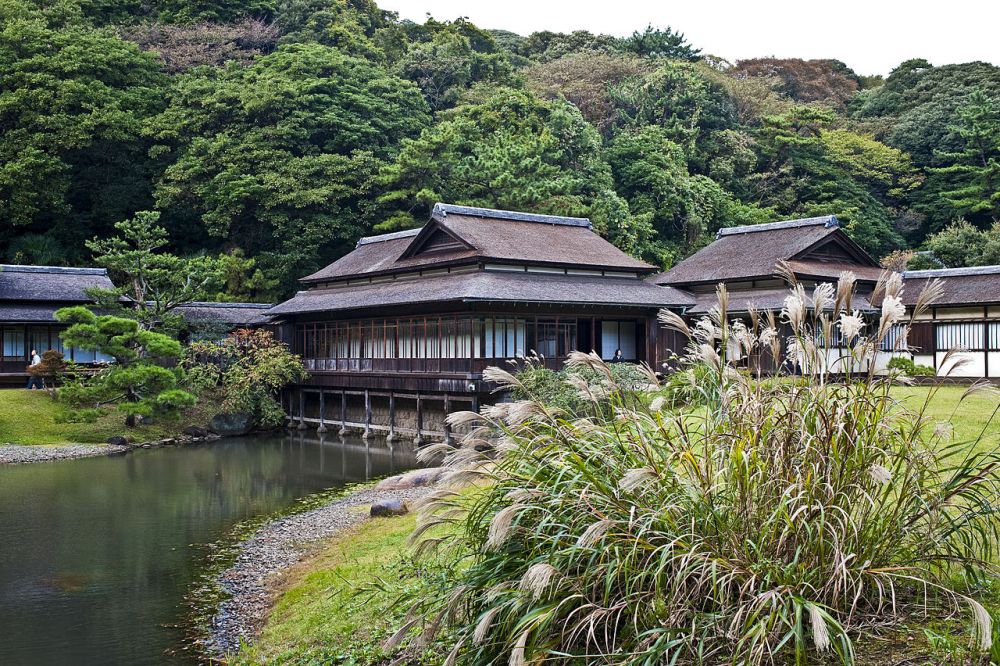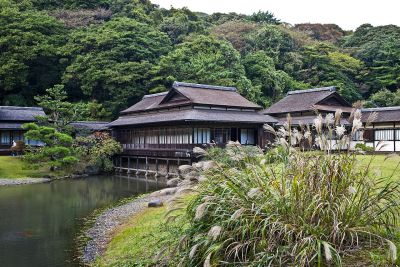

Sankeien Garden in Yokohama is a traditional Japanese-style garden that offers a spectacular view of cherry blossoms during the Sakura season, which typically occurs from late March to early April. As one of the most beloved activities in Japan, cherry blossom viewing, also known as 'Hanami,' is a beautiful and serene experience. Visitors can enjoy the picturesque scenery as they stroll along paths lined with a variety of cherry trees in full bloom. The garden, with its historic buildings and tranquil ponds, provides a perfect backdrop for photos. During this period, the garden often extends its hours and may have night illuminations, further enhancing the ethereal beauty of the delicate pink blossoms.
Sankeien Garden offers a quintessential Japanese cultural experience - the traditional tea ceremony. Within the picturesque setting, visitors can partake in this ceremonial preparation and presentation of matcha, Japanese green tea. The tea ceremony takes place in one of the historical tea houses located in the garden, offering a serene and authentic atmosphere. Participants learn about the philosophy of tea, which is deeply connected to Zen Buddhism and principles of hospitality, simplicity, and harmony with nature. The ceremony is a choreographed ritual of preparing and drinking matcha, accompanied by traditional sweets that complement the flavor of the tea.
Sankeien Garden is celebrated for its year-round floral displays that offer visitors a chance to witness the seasonal changes through the beauty of flowers. Spring showcases plums and cherry blossoms; summer is marked by hydrangeas and irises; autumn brings the warm colors of maples and ginkgo trees; and winter presents the delicate blooms of camellias and plum blossoms. Visitors can enjoy leisurely walks through the expansive grounds, taking in the vibrant hues and fragrances that change with the seasons. The garden carefully maintains various flower beds and groves, ensuring that something is always in bloom, providing a feast for the eyes and a tranquil respite from the bustle of the city.
Sankeien Garden is not only a place of natural beauty but also a haven of cultural and historic significance. Within the expansive grounds, visitors can discover a collection of historic buildings that have been carefully relocated from various parts of Japan. These buildings, spanning from the Kamakura to the Edo periods, include important cultural properties, such as an elegant daimyo (feudal lord) residence, rustic thatched-roof farmhouses, and even a three-story pagoda. Guided tours are often available, providing insights into the architecture and history of these structures. As you explore, you'll be transported back in time and gain a deeper understanding of Japan’s rich heritage.
Sankeien Garden, with its picturesque landscapes and historic buildings, is a photographer's paradise. The garden's distinct seasonal beauty provides a unique backdrop for photography enthusiasts. In spring, the cherry blossoms create a canvas of pink; summer's greenery is lush and vibrant; autumn leaves offer a rich tapestry of reds and golds; and winter gives a serene, minimalist landscape. The garden's reflective ponds, stone bridges, and traditional Japanese structures present ample subjects for both amateur and professional photographers. Apart from personal photography, it is also possible to book sessions for special occasions or to dress in traditional kimono for a photo shoot, providing a truly memorable experience.
During the autumn months, Sankeien Garden becomes even more magical with night illuminations that showcase the vibrant fall foliage. As the garden stays open after dusk, visitors can admire the illuminated maple and ginkgo trees, which cast a warm glow and create a mesmerizing atmosphere. This special event, known in Japanese as 'koyo,' offers a different perspective of the garden as the play of light and shadow enhances the natural beauty of the turning leaves. The reflections on the ponds add an extra layer of enchantment, inviting visitors to experience the tranquility and beauty of Sankeien under a starlit sky.
Sankeien Garden provides a cultural hub where visitors can engage in various traditional Japanese arts and crafts. Throughout the year, the garden hosts workshops and classes that might include activities such as ikebana (flower arranging), shodo (calligraphy), and traditional Japanese music. These workshops are often suitable for all ages and skill levels, offering a hands-on opportunity to learn and appreciate the intricacies of Japanese culture. The experience of learning a new skill while surrounded by the peaceful setting of the garden makes for an enriching and memorable experience.
During the summer months, notably in July, visitors to Sankeien Garden can witness the spectacular sight of blooming lotuses in the large pond situated near the garden's entrance. These elegant water plants open their large, fragrant flowers early in the morning and close in the afternoon, creating a delightful experience for early risers. The lotus, deeply symbolic in Buddhism for purity and enlightenment, provides a meditative subject for contemplation. The surrounding vistas are reflected in the water, offering beautiful photographic opportunities and a chance to enjoy a quiet moment in nature.
Sankeien Garden celebrates the Kiku Matsuri, a festival dedicated to the chrysanthemum, Japan's beloved autumn flower, during the month of November. Chrysanthemums, or 'kiku' in Japanese, hold significant cultural importance and are associated with longevity and rejuvenation. During the festival, the garden showcases a stunning array of chrysanthemums in various shapes, sizes, and colors. The meticulously cultivated flowers can be seen in elaborate displays, including ozukuri (large, dome-shaped arrangements), bonsai forms, and traditional cascades. Visitors can marvel at the intricacy of the blooms and the dedication of the gardeners in cultivating these exquisite flowers.
Sankeien Garden is an oasis of calm and natural beauty, making it an ideal place for nature walks and meditation. Visitors can wander through the meticulously maintained paths, discover hidden nooks, and sit by the tranquil ponds for moments of reflection. The garden is designed to embody the principle of borrowed scenery ('shakkei'), integrating the surrounding landscape into the garden's composition. Small hills, water features, and the careful placement of plants and rocks create a harmonious and meditative environment. The quiet atmosphere of the garden invites mindfulness and relaxation, offering a serene escape from the stresses of daily life.
